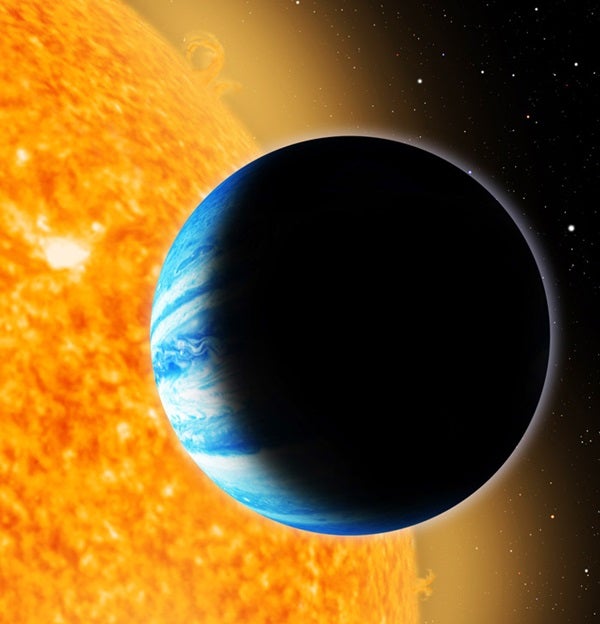“The discovery of Qatar-1b is a great achievement — one that further demonstrates Qatar’s commitment to becoming a leader in innovative science and research,” said Khalid Al Subai from the Qatar Foundation for Education, Science and Community Development in the Middle East.
“This discovery marks the beginning of a new era of collaborative astrophysics research between Qatar, the United Kingdom, and the United States,” he said.
The Qatar exoplanet survey hunts for stars that “wink,” dimming slightly every time an orbiting planet creates a mini eclipse by crossing in front of the star as seen from Earth. Transit searches like this must sift through thousands of stars to find the small fraction with detectable planets. The complex observations and analyses create perfect opportunities for teamwork.
“The discovery of Qatar-1b is a wonderful example of how science and modern communications can erase international borders and time zones,” said David Latham from CfA. “No one owns the stars. We can all be inspired by the discovery of distant worlds.”
To find the new world, Qatar’s wide-angle cameras, located in New Mexico, took images of the sky every clear night beginning in early 2010. Collaborating astronomers at St. Andrews and Leicester Universities and Qatar then transmitted the photographs to the United Kingdom for analysis. That analysis narrowed the field to a few hundred stars.
The Harvard-Smithsonian team, with Al Subai, followed up on the most promising candidates, making spectroscopic observations with the 60-inch-diameter telescope at the Smithsonian’s Whipple Observatory in Arizona. Such observations can weed out binary-star systems with grazing eclipses, which mimic planetary transits. They also measured the stars’ dimming more accurately with Whipple’s 48-inch telescope.
The resulting data confirmed the existence of a planet now called Qatar-1b, orbiting an orange type K star 550 light-years away. Qatar-1b is a gas giant 20 percent larger than Jupiter in diameter and 10 percent more massive. It belongs to the “hot Jupiter” family because it orbits 2.2 million miles (3.5 million kilometers) from its star — only 6 stellar radii away. The planet roasts at a temperature of around 2,000° Fahrenheit (1,100° Celsius).
Qatar-1b circles its star once every 1.4 days, meaning that its “year” is just 34 hours long. It’s expected to be tidally locked with the star so one side of the planet always faces the star. As a result, the planet spins on its axis once every 34 hours — 3 times slower than Jupiter, which rotates once in 10 hours.
“The discovery of Qatar-1b is a great achievement — one that further demonstrates Qatar’s commitment to becoming a leader in innovative science and research,” said Khalid Al Subai from the Qatar Foundation for Education, Science and Community Development in the Middle East.
“This discovery marks the beginning of a new era of collaborative astrophysics research between Qatar, the United Kingdom, and the United States,” he said.
The Qatar exoplanet survey hunts for stars that “wink,” dimming slightly every time an orbiting planet creates a mini eclipse by crossing in front of the star as seen from Earth. Transit searches like this must sift through thousands of stars to find the small fraction with detectable planets. The complex observations and analyses create perfect opportunities for teamwork.
“The discovery of Qatar-1b is a wonderful example of how science and modern communications can erase international borders and time zones,” said David Latham from CfA. “No one owns the stars. We can all be inspired by the discovery of distant worlds.”
To find the new world, Qatar’s wide-angle cameras, located in New Mexico, took images of the sky every clear night beginning in early 2010. Collaborating astronomers at St. Andrews and Leicester Universities and Qatar then transmitted the photographs to the United Kingdom for analysis. That analysis narrowed the field to a few hundred stars.
The Harvard-Smithsonian team, with Al Subai, followed up on the most promising candidates, making spectroscopic observations with the 60-inch-diameter telescope at the Smithsonian’s Whipple Observatory in Arizona. Such observations can weed out binary-star systems with grazing eclipses, which mimic planetary transits. They also measured the stars’ dimming more accurately with Whipple’s 48-inch telescope.
The resulting data confirmed the existence of a planet now called Qatar-1b, orbiting an orange type K star 550 light-years away. Qatar-1b is a gas giant 20 percent larger than Jupiter in diameter and 10 percent more massive. It belongs to the “hot Jupiter” family because it orbits 2.2 million miles (3.5 million kilometers) from its star — only 6 stellar radii away. The planet roasts at a temperature of around 2,000° Fahrenheit (1,100° Celsius).
Qatar-1b circles its star once every 1.4 days, meaning that its “year” is just 34 hours long. It’s expected to be tidally locked with the star so one side of the planet always faces the star. As a result, the planet spins on its axis once every 34 hours — 3 times slower than Jupiter, which rotates once in 10 hours.










